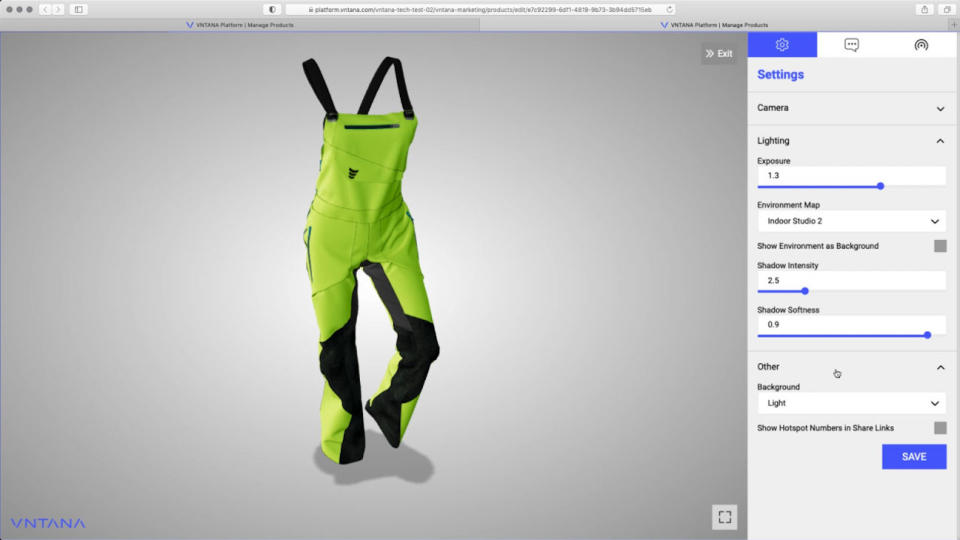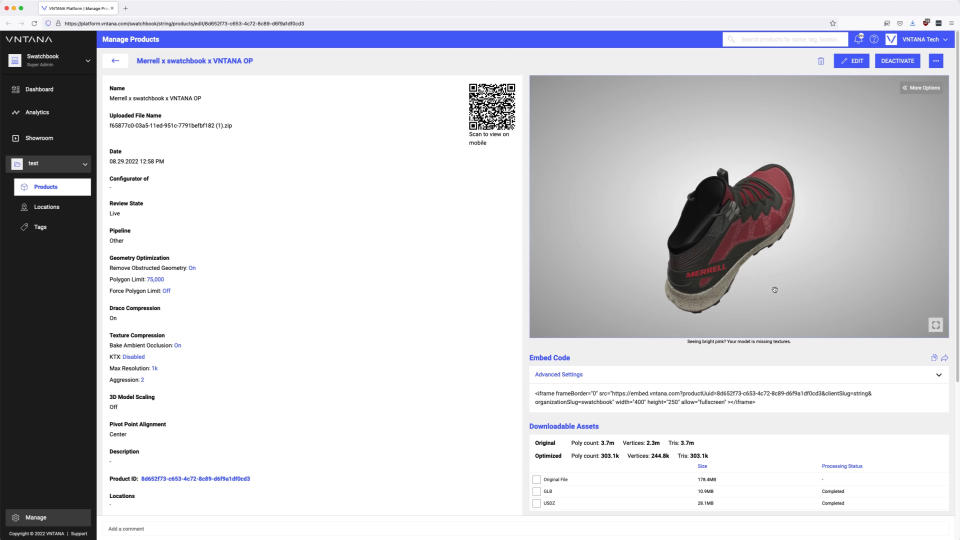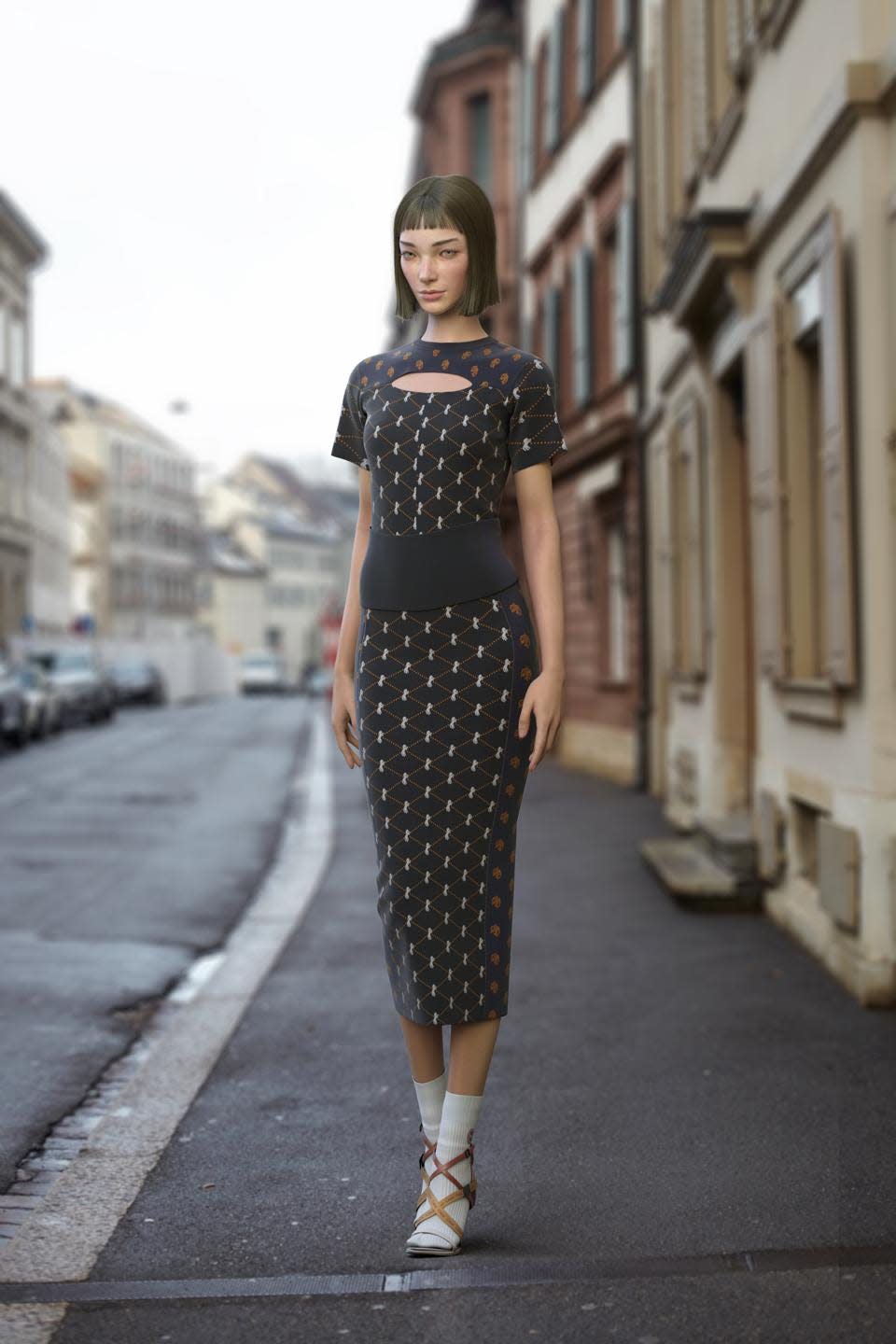The Future of E-Commerce is in 3D, Web3 and AI

Click here to read the full article.
The Earth is not flat and increasingly, neither is e-commerce.
Websites selling products in just two dimensions are giving way to 3D representations on desktop and mobile platforms, on store sites and on Google searches. It’s an inevitability Ashley Crowder saw coming in 2019 when she and co-founder Ben Conway established VNTANA, a software Crowder likens to a content management system for 3D marketing.
“Just like you would use Vimeo to upload and embed video, you use VNTANA to upload and embed 3D anywhere you need it,” Crowder told Sourcing Journal. “We’re not doing 2D to 3D but what we are doing is taking your existing 3D models and making them easy to share and compatible with the web, or wherever you’re trying to do it.”

Crowder said the idea for VNTANA was inspired by Internet car ads, which were the first to employ 3D sales techniques.
“The auto industry has used AutoCAD forever, but those files are way too big, and in the wrong format, which would take days of manual work by a 3D artist and we just got really sick of all that,” she said.
Three years on from the launch of its Beta version, VNTANA—its name an homage to the Spanish word for window, missing vowels and in all caps so as to signal everything Web3—boasts 50 clients, including footwear brands Hugo Boss, Wolverine Worldwide and Merrell.
In the apparel and footwear world, only the latter works especially well with the VNTANA technology that allows shoppers to get a 360-degree, 3D view of the shoe. The draping nature of clothing makes effective apparel presentations difficult and expensive to produce, Crowder said, though VNTANA does feature a 3D depiction of clothing on a virtual mannequin that can be viewed from every angle.
“Clothing try-on isn’t there yet. The physics of fabric in digital is still being figured out,” Crowder said. “But we can do footwear and accessories like a watch you can try on and things like that. What we’ve found is even without the try-on—just being able to see the product better—is increasing conversion rate.”
Crowder said 3D footwear presentations on e-commerce are yielding a 6 percent increase in conversion rate with returns reduced by 40 percent.
“We can automatically publish your 3D asset to Google search, we can publish it to Amazon and storefronts have also started rolling this out,” Crowder said. “We’re kind of like that content management system that lets you get your 3D everywhere you need to go.”

In addition to 3D, VNTANA offers augmented reality through a QR code that, when activated on a smartphone, allows the shopper to project the object onto a flat surface in 3D. The 3D assets can also translate seamlessly into 2D assets, so a business can actually save on expenses by photographing products in 3D only.
“3D is the highest level asset you can have, so you can create anything you want. You can change the color, the texture, see all the options that are available,” Crowder said. “As a brand, I can also automatically generate all the images I want from that 3D model, so I no longer need a photo shoot. If you get IKEA’s kitchen catalog in the mail, not a single photo was taken. That’s all renderings from 3D content.”
Crowder said Google is currently performing A/B tests on 3D presentations, wherein only some users will see it. She expects it to go live to all Google users at some point this year.
“I think this year is going to be a turning point, especially when you have big platforms like Google and Amazon and others that, the minute they switch this on for everybody, if your competitor is doing a 3D ad and their Google search is beating you on SEO, you’ve got to do it,” Crowder said. “I think it’s going to, all of a sudden, be a very quick race.”
The metaverse fitting room
While the technology for practical and accessible 3D clothing representations is still on its way, the metaverse has developed try-on options for items that exist in the real world.
The recently launched Web3 site ALTAVA by longtime Korean game designer Andy Ku allows users to create their avatars with striking similarity to their physical bodies and try on clothes from 40 of the world’s top fashion brands, including Burberry, Bulgari, Diesel and Thom Browne. If a user likes what they see, they can not only purchase the pieces for their avatar at about 1 percent of the real-world cost, with a click they can be redirected to that brand’s e-commerce site and buy that very garment IRL.

“It’s a virtual fitting room, combined with a kind of e-commerce UI (user interface) where you can filter by types of categories, by brands, colors—whatever,” Ku told Sourcing Journal. “It’s just like doing e-commerce shopping. You click and you put it on your avatar and you can rotate, zoom in, zoom out and see the full 3D look of the fashion.”
As for the fully sensory try-on experience, Ku agreed with Crowder that the technology currently exists, but will remain too expensive to implement for at least the next few years. But the imminent rise of 3D and Web3 in the e-commerce space can’t be ignored.
“That’s why the brands ignored e-commerce in the beginning because they thought no one’s going to purchase $10,000 luxury fashion through online where you can’t feel anything,” Ku said. “The 3D experience actually enhances the current 2D, flat e-commerce experience but e-commerce does not have any of the haptic or where you can feel the garment, but people are still making tons of purchases through Farfetch without ever trying them on. So I think the behavior pattern has changed, even in the Web2 e-commerce experience, and Web3, the metaverse, we only enhance that going forward.”
Ku said he’s not privy to the conversion rates on physical world sales, as that data would be kept by the retailers themselves, but he said, in the Korea market alone, ALTAVA averages 200,000 to 300,000 try-ons per month with a 2 to 2.5 percent sales average on the digital items.
“I think the metaverse is the best, most efficient way to promote products whether luxury or not,” Ku said. “We’re not just showcasing and selling the virtual goods; all of our virtual goods are linked with physical goods, so there’s an access for users to go in and purchase the real physical product directly.”
Look forward to Altava land+ c2e soon. This will be at the top of every fashion game. The listed Tava Coin has a user-to-user transaction. pic.twitter.com/oBrioC6lKf
— Mok (@tkdduq75) March 9, 2023
As is custom in Web3, ALTAVA conducts business through cryptocurrency, and in its case has gone so far as to create its own. Called Tava Utility Tokens, these allow the purchase of NFTs that can be translated into physical world transactions, a concept that he first developed with his 2007 hit fashion-based video game MStar, which at its peak was selling a whopping $83 per user, per month in digital fashion, an impressive average considering it was the same year the first iPhone was launched.
In the game, which Ku later sold, players would interact in a high society, fashion world and gain credits they could use for actual purchases based on their social performance in this virtual world. That foundation forms the baseline concept behind ALTAVA.
“We had that state-of-the-art avatar, where we had the best graphical system to represent fashion motions—as close as you can get to the real,” Ku said. “So with that, we decided to create the next big social based game and platform. I think the concept is basically what Metaverse is today; we were just 10 years earlier.”
In December 2022, ALTAVA announced a partnership with Metaverse World, a blockchain infrastructure, to create 1,000 Bored Ape characters in stereotypical golf clothing to form the Bored Ape Golf Club, a derivative of the highly popular Bored Ape Yacht Club. The BAGC will sell apparel, footwear and even golf equipment.

AI for the Amazon jungle
The rapid evolution of e-commerce isn’t just about the visuals—it’s about the text too, and in that wild world of algorithms and search optimization comes Jungle Scout.
Launched officially on March 14, the AI feature promises an instant product listing meant to help vendors on Amazon rank higher allowing customers to find what they’re looking for more easily.
“Most people spend several hours on the Amazon detail page filling it out, tweaking it to get it exactly right to get the best result, and you’re constantly doing that,” Stephen Curial, chief technology officer for Jungle Scout, told Sourcing Journal. “What we’ve done is created AI assist so you can go and have it actually just generated for you, just based off those keywords.”
The function, now available under Jungle Scout’s Professional Plan at $89 per month, provides Amazon analytics based on search terms, and when crafting a sales post, its window-by-window process shows by percentage the optimization performance of each entry. Beyond that, the AI feature will even compose a title and copywriting for the product.
“We’re trying to help make sellers’ lives easier; help them save time, help them create better descriptions to help open up new markets,” Curial said. “How do we make it simpler for them and make them have a successful business. Because if they’re going to keep selling on Amazon, they’re going to be successful and they’re going to keep using our tools.”
Given AI’s propensity for factual errors, aka “hallucinations,” users need to review and edit all of Jungle Scout’s creations before publishing.
“The AI assist is just generating the language and the content of using those and making them appear,” Curial said. “And then on Amazon’s end, it’s an informational retrieval model. So it’s an inverse index that’s actually going to try and match and rank keywords to products and Amazon’s model is trying to maximize conversion.”
Where AI excels particularly is translating copy into foreign languages, an increasingly important tool in the e-commerce marketplace.
“You can now ship your inventory and Amazon manages it. You don’t need to have a warehouse; you don’t need to have employees in another country,” Curial said. “The [AI] models are really good at translating languages, and now we’re to the point where, because Amazon provides customer service, you don’t necessarily need to speak a language to be able to sell in [international] markets.”

